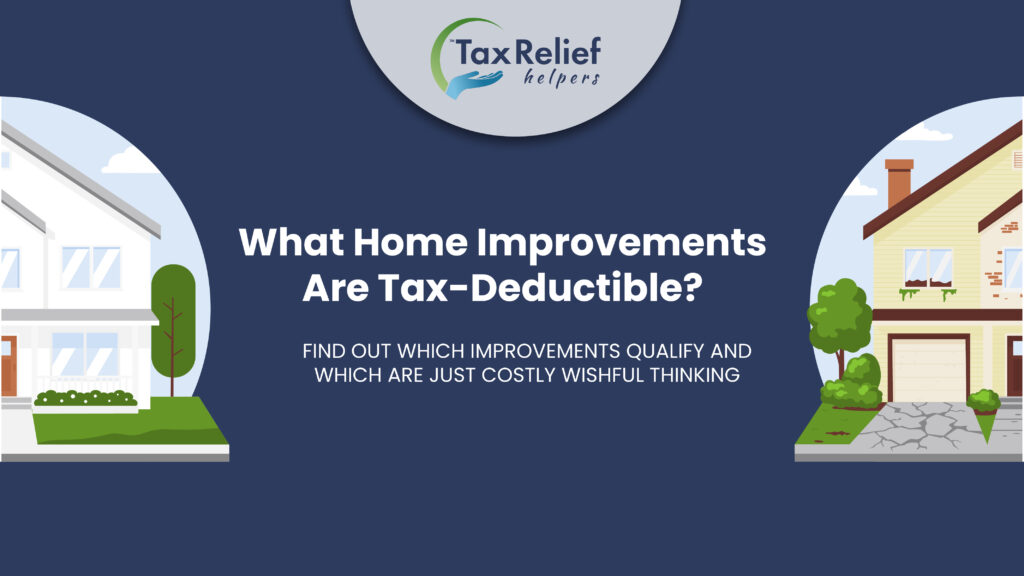When tax season rolls around, many homeowners wonder: What home improvements are tax-deductible? Whether you’re upgrading your living space, increasing energy efficiency, or making your home more accessible, it’s essential to know which renovations could also bring you financial benefits when filing your taxes.
Unfortunately, not all home upgrades qualify. However, with the right knowledge, you can make smart decisions that improve your home and reduce your tax burden.
What are Tax Deductions for Home Improvements?
Before you assume your latest remodel qualifies for a tax break, it’s important to understand how the IRS distinguishes between improvements and repairs.
Home Improvements vs. Repairs
- Home improvements are typically long-term upgrades that increase your home’s value or extend its useful life. These include additions, full kitchen renovations, new roofing, and other capital enhancements.
- Repairs, on the other hand, are fixes that keep your home in working condition, think patching a leaky roof or replacing broken windows. These are not tax-deductible.
IRS Classification
The IRS considers capital improvements to be tax-relevant. These upgrades may not offer immediate deductions, but they increase the basis (original value) of your property, potentially reducing capital gains tax when you sell.
When Can You Claim a Tax Deduction for Improvements?
Not all home improvements are immediately deductible, but certain upgrades can offer tax advantages under specific circumstances. Here’s a breakdown of how and when you might benefit from tax deductions or credits:
1. At the Time of Sale – Capital Gains Adjustment
When you sell your home, improvements classified as capital improvements, those that add value to your home, prolong its life, or adapt it to new uses, can be added to your home’s cost basis. This reduces the capital gain you’ll report on the sale, potentially lowering your tax liability.
What Qualifies as a Capital Improvement?
Some common capital improvements include:
- Room additions
- New plumbing or electrical systems
- Installing a new HVAC system
- Replacing the roof
- Upgrading the kitchen or bathroom
These expenses increase your home’s value and may qualify as adjustments to the home’s basis when calculating capital gains.
What Are the Tax Implications?
You won’t receive a deduction in the year you spend the money. However, by keeping records, you’ll benefit later when selling the home. These improvements lower your taxable gain, a huge plus if your home’s value has appreciated significantly.
Which Energy-Efficient Upgrades Qualify for Tax Credits?
If you’ve invested in making your home more energy-efficient, you may be eligible for federal energy tax credits through the Residential Clean Energy Credit or the Energy Efficient Home 3. Medical Deductions – Itemized on Schedule A
Investing in energy-efficient improvements not only lowers utility bills but may also earn you federal tax credits.
Eligible Projects:
- Solar panels and solar water heaters
- Energy-efficient windows and doors
- High-efficiency HVAC systems
- Biomass stoves
- Insulation and certain roofing materials
IRS Form 5695
Use IRS Form 5695 to claim the Residential Energy Credits. In 2024, you may be eligible for credits up to 30% of the improvement costs, depending on the type of upgrade.
For more detailed guidance, visit IRS Residential Energy Credits.
Which Medical Home Improvements Qualify as Tax-Deductible Expenses?
If a home improvement is made primarily for medical reasons, and it doesn’t add value to the property, it may be deductible as a medical expense when you itemize deductions. If you or someone in your home has special medical needs, some home modifications could be tax-deductible.
Qualifying Medical Modifications:
- Installing ramps or elevators
- Widening doorways
- Adding handrails or grab bars
- Modifying bathrooms
Requirements:
- The improvement must be medically necessary, not just for convenience.
- You must itemize deductions using Schedule A.
- Only the amount above the increase in property value is deductible.
For instance, if you spend $8,000 on a ramp that adds $3,000 in value to your home, only $5,000 may be deductible.
Which Home Office Improvements Are Tax-Deductible?
With remote work on the rise, many people wonder if home office renovations are deductible.
Rules for Deductibility:
- You must use the space exclusively and regularly for work.
- The improvement must benefit only the office area.
Examples:
- Building a separate office structure
- Adding built-in desks or shelves to the workspace
- Soundproofing a room used for recording or meetings
Important Note:
Only self-employed individuals or small business owners can typically claim these deductions. Employees working remotely due to employer policy may not qualify under current IRS rules.
Improvements That Are NOT Tax-Deductible
It’s equally important to know what doesn’t qualify to avoid false assumptions.
Common Non-Deductible Projects:
- Cosmetic upgrades (e.g., wallpaper, paint)
- Routine maintenance (e.g., gutter cleaning, lawn mowing)
- Landscaping (except in rare cases tied to medical use or energy credits)
- Replacing appliances (unless energy-efficient models qualify for credits)
Always check the IRS website or consult a tax advisor before assuming deductibility.
How to Document Home Improvements for Tax Purposes
Proper documentation is essential to validate your deductions and avoid IRS disputes.
What to Keep:
- Receipts and invoices showing the cost, vendor, and date
- Contracts outlining the scope of work
- Permits and inspection documents
- Photos before and after (helpful for capital improvements or audits)
Retention Timeline:
- Keep records for at least 3 years after filing the tax return.
- If tied to capital improvements, hold onto them until 3 years after the sale of the home.
Conclusion
Home improvements can be more than just a way to beautify or modernize your space—they can also serve as a strategic financial move. From energy-efficient tax credits to medical-related deductions and capital gains adjustments, knowing what home improvements are tax-deductible puts you in a better position come tax time.
To make the most of your efforts:
- Plan projects with tax benefits in mind.
- Keep thorough records.
- Consult a tax professional when in doubt.
Written by: Thomas Brooks
Published: September 8, 2025
